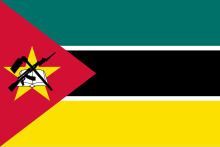 | |
| Data | |
|---|---|
| Water coverage (broad definition) | 47% (2015)[1] |
| Sanitation coverage (broad definition) | 24% (2015)[1] |
| Continuity of supply | 12–14 hours (Maputo in 2007), 22–24 hours (Beira, Quelimane, Nampula, Pemba in 2007)[2] |
| Average urban water use (L/person/day) | n/a |
| Average urban water and sanitation tariff (US$/m3) | 12,500 Meticais/m3 (US$0.54/m3) in Maputo and between 10,200 and 11,2000 Meticais/m3 (0.44–0.49/m3) in Beira, Quelimane, Nampula and Pemba (2005)[3] |
| Share of household metering | Low |
| Annual investment in WSS | n/a |
| Share of external financing | 85% external financing (2006–2008) |
| Institutions | |
| Decentralization to municipalities | Yes |
| National water and sanitation company | Two asset-holding companies: FIPAG for water in large cities; AIAS for sanitation in large cities and water supply in small towns |
| Water and sanitation regulator | CRA |
| Responsibility for policy setting | Ministry of Public Works and Housing |
| Sector law | No |
| No. of urban service providers | n/a |
| No. of rural service providers | n/a |
Water supply and sanitation in Mozambique is characterized by low levels of access to at least basic water sources (estimated to be 47% in 2015), low levels of access to at least basic sanitation (estimated to be 24% in 2015) and mostly poor service quality. In 2007 the government has defined a strategy for water supply and sanitation in rural areas, where 62% of the population lives. In urban areas, water is supplied by informal small-scale providers and by formal providers.
Beginning in 1998, Mozambique has reformed the formal part of the urban water supply sector through the creation of an independent regulatory agency called CRA, an asset-holding company called FIPAG and a public-private partnership (PPP) with a company called Aguas de Moçambique. The PPP covered those areas of the capital and of four other cities that had access to formal water supply systems. However, the PPP ended when the management contracts for four cities expired in 2008 and when the foreign partner of the company that serves the capital under a lease contract withdrew in 2010, claiming heavy losses.
While urban water supply has received considerable policy attention, the government has no strategy for urban sanitation yet. External donors finance about 85% of all public investments in the sector. The main donors in the water sector are the World Bank, the African Development Bank, Canada, the Netherlands, Sweden, Switzerland and the United States.